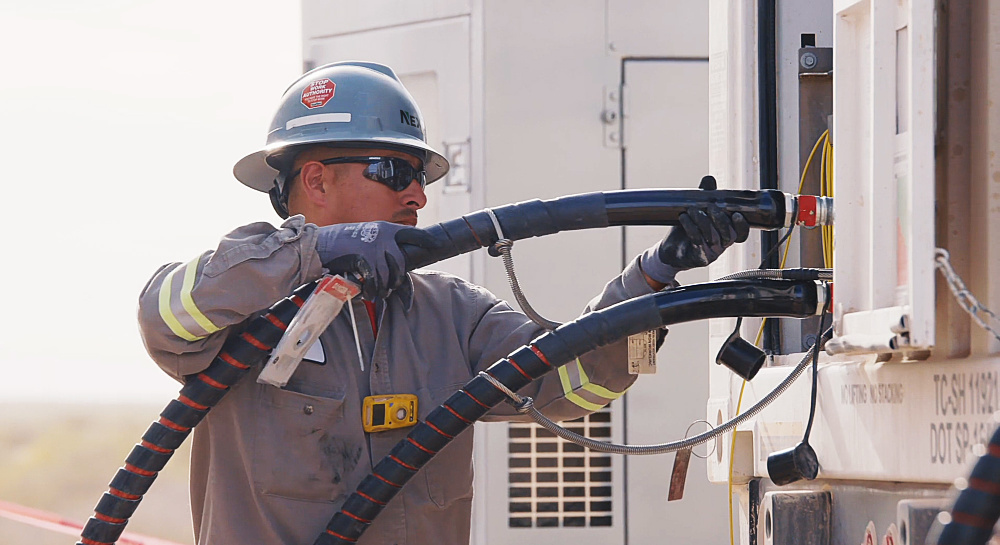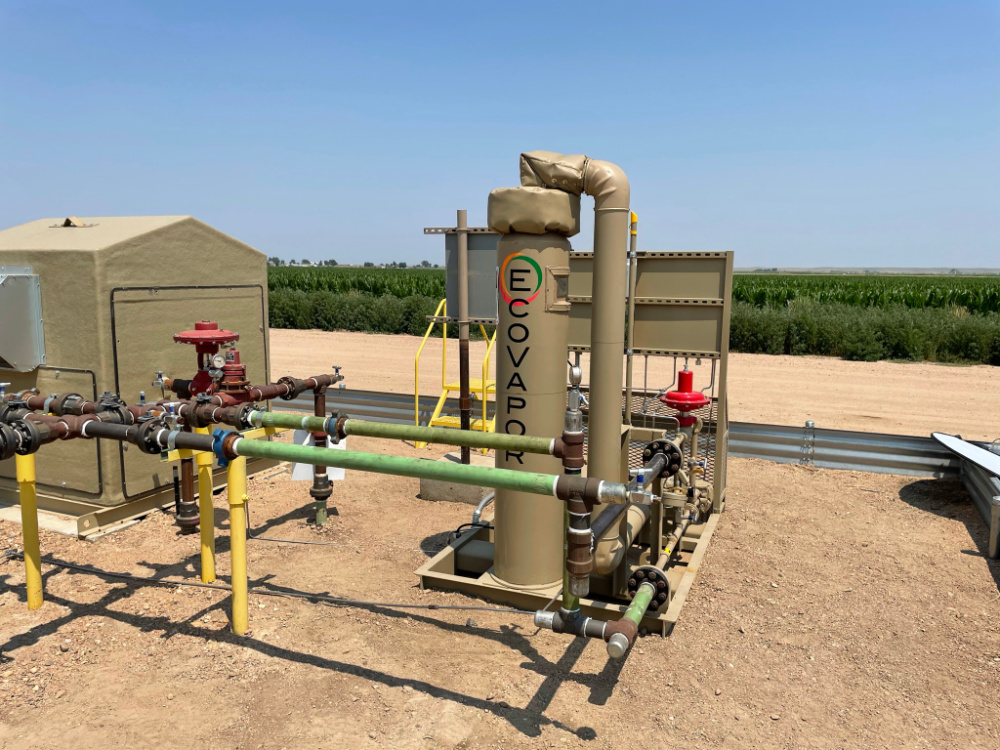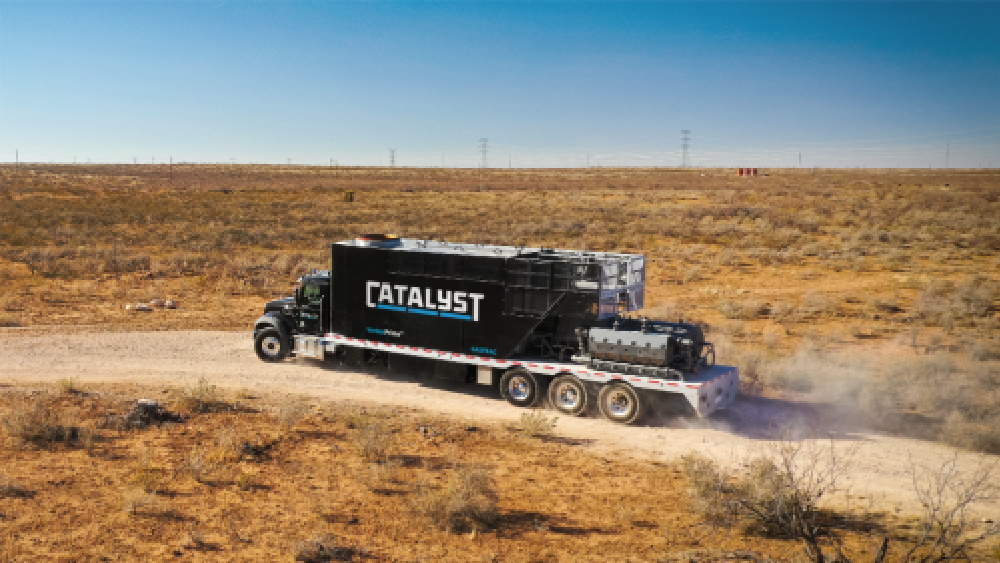This story will appear in the upcoming Hydraulic Fracturing special report presented by:
A combination of favorable market factors, including higher and stabilized commodity prices, proven returns on ESG investments and a push to increase production, has created an environment in which shale producers are adopting emissions-reducing technologies at the frac site with greater frequency.
That rapid adoption of both greenhouse-gas reduction practices and new technology deployment could lead many companies with stated net-zero goals to achieve those aspirations by the middle of the decade.
According to a report issued by Wood Mackenzie, “Most Scope 1 emissions could be addressed by mid-decade, given progress companies have made already. Look for continued capex spend of more than $100 million per year for many companies to continue the significant reduction.”
Methane and flaring emissions are quickly falling for many companies, as high natural gas prices have encouraged companies to sell associated gas rather than flare, while technologies being deployed at the well site are helping monitor, identify and even monetize leaked gasses.
“Most Scope 1 emissions could be addressed by mid-decade given progress companies have made already. Look for continued capex spend of more than $100 million per year for many companies to continue the significant reduction.”—Wood Mackenzie
For many companies, reducing their emissions profile starts at the well site even before production begins. Decreasing a reliance on diesel fuel for fracking equipment helps cut down on CO₂ emissions. And later during the production phase, knowing where leaks may occur and having the ability to predict when and where those leaks are helps bring emissions reduction efforts to the full life cycle of the well.
Alternative power generation
When it comes to reducing emissions at the frac site, perhaps no fruit hangs lower than cutting diesel consumption on frac fleets.
In August 2021, NexTier Oilfield Solutions announced its Power Solutions division, which includes the integration of its CNG supply and field gas handling technologies. The company has paired its CNG fueling and blending system with its Diesel Displacement App, which provides real-time performance monitoring that shows how much diesel is being offset by NexTier’s dual-fuel fleets.
“Visualizing means that we’re able to improve, make immediate decisions and use data to actually drive how we’re using the pumps, which all goes back to displacing more diesel with natural gas and lowering overall costs and emissions,” said Ben Dickinson, NexTier director, quality and NexHub operations.
NexTier has emerged as a leader in providing Dynamic Gas Blending fleets in the U.S., which Dickinson said can help meet the needs of operators focusing on using as much natural gas as possible and lowering their emissions profile.
“Every client is interested in lowering emissions,” he said. “Every client is interested in using more natural gas in order to lower overall costs. The conversation we have with clients is about how do we get there with the type of equipment that they would like to use, and also with the type of fuel source they have available in their region.”
Dickinson explained that the NexHub application helps operators lower CO₂ emissions and reduce fuel costs by providing insights that maximize natural gas usage in dual-fuel frac equipment.
That equipment, according to NexTier, can use compressed natural gas and the operator’s field gas at the well site, with both options providing a reduction in carbon footprint and lower cost compared to diesel.
Leading service companies are deploying fleets that utilize Tier IV dual fuel, or dynamic gas blending engines, and compressed natural gas (CNG) to help producers use less diesel fuel for fracking equipment.

Meanwhile, Midland, Texas-based Catalyst Energy Services’ VortexPrime fleet features a direct-drive turbine technology powered by natural gas. The VortexPrime provides up to 15,000 psi working pressure and up to 25 bbl/min per pump.
“We take a military-grade turbine and we power it with natural gas,” said Seth Moore, Catalyst executive vice president and COO. “We couple that to a drive train, and we turn a pump with it directly. So, we’re not generating electricity or hydraulic power to power a mechanical pump. We’re doing it directly. And that produces a very efficient exchange of the BTU [British thermal unit] of the natural gas down into a hydraulic horsepower. The difference is that we’re not burning nearly as much liquid fuels.”
Moore explained that upward of 93% of the fuel consumed at the well site is allocated for pressure pumping equipment. He said 90% of that diesel consumed and being burned can be replaced by natural gas. A typical diesel-powered fleet could burn as much as 2,700 gallons of diesel per hour, Moore said.
“So, you’re replacing diesel consumption with natural gas consumption, and natural gas is a cleaner burning fuel with less greenhouse gasses and less [nitrogen oxide].”
According to Catalyst, the VortexPrime fleet is fully self-contained and requires six to eight pumps versus a traditional standard fleet that might require up to 20 pumps. The company reports that a five-pump fleet can deliver 100 bbl/min of fluid at 10,500 psi while taking up 55% less space onsite than a standard fleet.
That smaller footprint helps lower a company’s emissions profile as well, Moore explained.
“When you go from 24 pumps to eight pumps, then everything else starts shrinking as well,” he said. “There’s secondary and tertiary benefits of that. For example, the number of manifolds we need, all of the piping on location that is needed to hook up all of this equipment, there is less of that. It’s maybe one-third of what it was before, so we have to purchase less of it, [and] we have to haul less of it. We have to repair and maintain less of it. We may not know how to quantify that, but the environmental benefits are not insignificant.”
Managing emission leaks
Once a well is on production, harmful emissions can find their way into the atmosphere at any number of points along the production cycle. From lifting facilities to pipelines to separators to storage tanks, the production phase is one of the most critical components of every emission-reduction strategy.
EcoVapor Recovery Systems’ variety of technologies helps reduce flaring by ensuring low-pressure gas can be sold at pipeline specifications, which also monetizes wasted gas.
“Our whole business is centered around eliminating waste,” said CEO Jason Roe. “When you look at things like flaring, venting of gas, even fugitive emissions of gas, that’s wasted product our industry works hard to produce. We work hard to eliminate the flaring and venting of natural gas.”
One of the technologies EcoVapor deploys is its ZerO2 vapor recovery system that enables operators to capture nearly all of the low-pressure tank vapor. That captured gas can then be sold, Roe said.
“The tank battery can be a large source of emissions, whether it be flaring those vapor streams coming from the tanks, or worse, if it’s just being vented from the tanks themselves,” he said. “We purify these gas streams captured via vapor recovery units, which are these really high BTU-rich gas streams so you can actually get a premium for it. So, where we play a role is the purification of these gas streams.”

Roe described tanks as “in-breathing and out-breathing,” and artificial gas blankets to keep air out could lead to an increase in the venting of that gas. “In-breathing,” he said, can bring air, and thereby oxygen, into the tanks, which can cause corrosion, particularly in the downstream pipeline network.
“The pipeline network has pretty tight specifications on the amount of oxygen it will allow into the network,” Roe said. “With that in mind, our core ZerO2 product eliminates oxygen from these tank vapor streams, ensuring that 100% of this gas stream is moving to the sales pipeline.”
With the price of Henry Hub hovering around $6/MMBtu, Roe said operators have been additionally incentivized with monetizing previously vented or flared natural gas.
“We have some operators that evaluate our products purely on an economic basis,” he said. “By helping them to monetize the richest gas stream from their site without the concern of being shut in by their takeaway providers due to oxygen contamination, the economic case is very strong.”
He also said that some operators just want to minimize their emissions by eliminating flaring, regardless of gas prices.
“A lot of times environmental solutions in the market today are asking operators to choose between economic performance and environmental performance,” Roe said. “And fortunately for us, we don’t force them to make that decision. They benefit financially as well as environmentally.”
End-to-end solutions
Honeywell is in the midst of bringing to market an end-to-end portfolio of emissions management tools and technologies from field devices to site operational software to enterprise emissions monitoring platforms. The system would adopt Honeywell’s existing battery energy storage technologies, renewable energy solutions and hydrogen and carbon capture technologies.
“We’re very focused on getting some quick wins for our customers in reducing their emissions and also enable them to align with upcoming legislation, whether that be from the EPA [Environmental Protection Agency], whether that be financial reporting requirements from the SEC [Securities and Exchange Commission] and outside the U.S. within the European commission,” said Adrian Fielding, general manager of emissions monitoring and reduction for Honeywell.
He said that effort has led the company to focus primarily on methane as the first greenhouse gas it wants to manage.
“Over a 24-year life cycle, [methane] is 34% more potent as a greenhouse gas than CO₂, and over 100 years, 25% [more potent],” Fielding said.

Among the systems Honeywell has introduced is its Gas Cloud imaging solution, which Fielding described as a video verification leak detection and quantification camera system. Another new technology deployment centers on continuous leak detection.
Fielding explained that current solutions often involve leak detection and quantification technologies, which offers periodic testing of anything that could potentially leak—primarily flanges, values and pumps.
“We’re going to supplement that solution with near real-time continuous monitoring,” he said.
By adding continuous monitoring to wellsite components that are prone to methane leaks, “you’re detecting the leak when it happens,” Fielding said.
“If we were doing this and repairing it every time we saw a leak, then the downtime of operations would be quite significant,” he said. “So for an operator, it’s important to do a couple of things: try and align the repairs where it’s cost-effective to do so and also to be able to trend and predict when they might need those repairs.”
Meanwhile, Honeywell is also in the proof-of-concept stage for a version of its Rebellion Gas Cloud Imaging cameras that can be applied adjacent to a leak source.
“It’s deployed in a swarm, so multiple devices, and because it’s deployed in a swarm, the software analytics enable us to identify the potential leak source and give us a plus or minus 1-meter location, so that’s pretty accurate,” Fielding said.
Recommended Reading
Santos’ Pikka Phase 1 in Alaska to Deliver First Oil by 2026
2024-04-18 - Australia's Santos expects first oil to flow from the 80,000 bbl/d Pikka Phase 1 project in Alaska by 2026, diversifying Santos' portfolio and reducing geographic concentration risk.
Iraq to Seek Bids for Oil, Gas Contracts April 27
2024-04-18 - Iraq will auction 30 new oil and gas projects in two licensing rounds distributed across the country.
Vår Energi Hits Oil with Ringhorne North
2024-04-17 - Vår Energi’s North Sea discovery de-risks drilling prospects in the area and could be tied back to Balder area infrastructure.
Tethys Oil Releases March Production Results
2024-04-17 - Tethys Oil said the official selling price of its Oman Export Blend oil was $78.75/bbl.
Exxon Mobil Guyana Awards Two Contracts for its Whiptail Project
2024-04-16 - Exxon Mobil Guyana awarded Strohm and TechnipFMC with contracts for its Whiptail Project located offshore in Guyana’s Stabroek Block.





